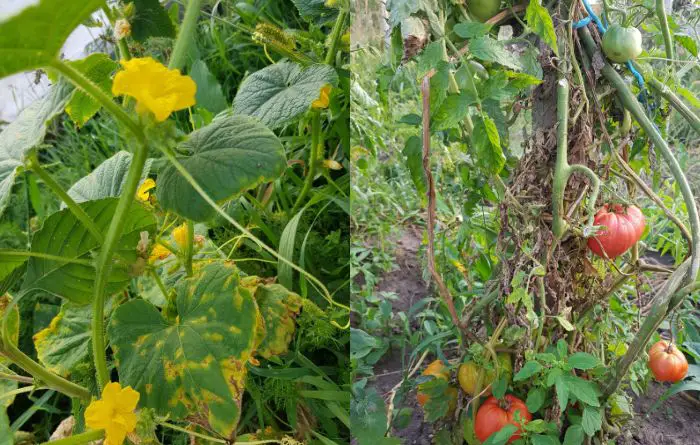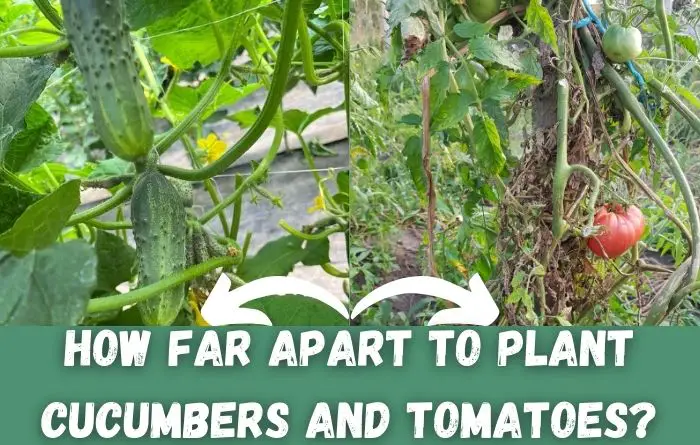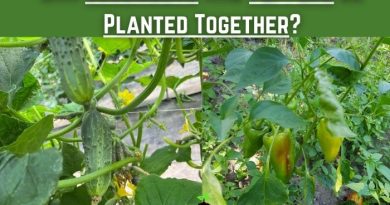How Far Apart to Plant Cucumbers and Tomatoes? (Quick Answer)
Have you ever wondered, ‘How far apart should I plant my cucumbers and tomatoes? I’m here to share my knowledge on the optimal plant spacing for these two delicious crops to help promote healthy development and maximize the space in your garden.
Cucumbers and tomatoes should be planted about 18 to 24 inches (45.72 to 60.96 cm) apart in rows that are spaced between 3 to 4 feet (91.44 to 121.92 cm) apart. This spacing ensures that the plants have enough room to grow and receive adequate sunlight, which can help prevent diseases, and overcrowding, and increase yield.
Key takeaways:
- Proper plant spacing is crucial: Cucumbers and tomatoes should be planted at appropriate distances to promote healthy growth and prevent overcrowding. This ensures proper airflow, sunlight exposure, and reduces the risk of disease.
- Factors to consider in plant spacing: When deciding how far apart to plant cucumbers and tomatoes, factors such as variety, growth habit, and available space should be taken into account. Paying attention to these factors will optimize plant growth and yield.
- Companion planting benefits: Companion planting cucumbers and tomatoes with compatible plants can enhance growth, deter pests, and improve overall plant health. Understanding which plants work well together can maximize the benefits for both cucumbers and tomatoes.
How Far Apart Should Cucumbers and Tomatoes Be Planted?
Plant spacing is crucial for the successful growth of cucumbers and tomatoes. Knowing how far apart to plant them can make all the difference in your garden.
Here is a table with the recommended plant spacing for cucumbers and tomatoes:
| Plant | Spacing | Recommended Distance |
|---|---|---|
| Cucumbers and Tomatoes | Rows | 18-24 inches (45.72 to 60.96 cm) |
| Cucumbers and Tomatoes | Hills | 36-60 inches (91.44 to 152.4 cm) |
For cucumbers, the recommended spacing between plants is typically 18-24 inches (45.72 to 60.96 cm) in rows that are spaced 3-4 feet (91.44 to 121.92 cm) apart. This particular spacing allows the cucumbers enough room to grow and receive sunlight, which is important for disease prevention and maximizing yield.
If you prefer planting cucumbers in hills ensure a spacing of 36-60 inches (91.44 to 152.4 cm) between them. Alternatively, if you choose to grow cucumbers on a trellis you can bring the plants together and maintain a space of about 1 foot between each cucumber plant, on the trellis.
For tomatoes, the recommended spacing between plants should be a distance of 18-36 inches (45.72 to 91.44 cm) between each plant in rows that are spaced 3 4 feet (91.44 to 121.92 cm) apart.
Determinate tomatoes need space compared to indeterminate varieties. If you prefer planting tomatoes in hills make sure to leave a gap of 36-60 inches (91.44 to 152.4 cm) between each plant.
The following table provides the recommended plant spacing for cucumbers and tomatoes based on the planting method:
| Planting Method | Cucumbers | Tomatoes |
|---|---|---|
| In Rows | 12-24 inches apart, with 3-4 feet between rows | 18-36 inches apart, with 3-4 feet between rows |
| In Hills | 3-4 plants per hill, with hills spaced 3-4 feet apart | 1-2 plants per hill, with hills spaced 3-4 feet apart |
| On Trellises | 6-12 inches apart, with trellises spaced 3-4 feet apart | 12-24 inches apart, with trellises spaced 3-4 feet apart |
When planting cucumbers and tomatoes together, it’s important to consider the spacing requirements for both plants. The recommended spacing for both plants is typically the same, with 18-24 inches (45.72 to 60.96 cm) between rows and 36-60 inches (91.44 to 152.4 cm) between hills.
In summary, proper plant spacing is essential for healthy growth and maximum yield for both cucumbers and tomatoes. Follow the recommended spacing guidelines for your specific variety and gardening style, and consider companion planting to maximize the use of space in your garden beds or containers.
Factors that Influence Plant Spacing
In this section, we’ll uncover the factors that need to be considered when determining the ideal spacing for these vegetables:
- Size of plants at maturity: Different plants have varying sizes when they reach maturity. It is crucial to determine the spacing for each plant so that they have enough room to grow. For example tomatoes can grow as tall as 6 to 8 feet which means they need space compared to cucumbers, which usually reach heights of about 2 to 3 feet.
- Root systems: The size of a plants root system also plays a role in determining the required spacing. Plants with root systems need more space to spread out and access nutrients and water in the soil. It is important not to overcrowd plants so their roots can grow without competing with neighboring plants. This aspect is especially important for plants like tomatoes as they have root systems.
- Sunlight requirements: Another factor to consider is the sunlight requirements of plants. Some plants like tomatoes thrive in sun while others like cucumbers can tolerate partial shade. Therefore it’s essential to allocate spacing based on the sunlight needs of each plant to ensure they receive sunlight, for optimal growth.
Ensuring adequate spacing between your cucumbers and tomatoes is crucial for their well-being and productivity.
It’s important to consider factors, like the size of the plants, their root systems and their sunlight needs when determining how much space each plant should have. This way we can guarantee that every plant has room to flourish and access the resources it needs to thrive.
Benefits of Planting Cucumbers near Tomatoes
When it comes to companion planting, cucumbers and tomatoes are often mentioned together. Many gardeners believe that planting them together can be beneficial for both plants.
In this section, I will discuss the benefits of companion planting cucumbers and tomatoes:
- Pest Management: When it comes to dealing with pests like aphids, spider mites and whiteflies cucumbers and tomatoes are both vulnerable. However planting these two crops together can actually help prevent pest issues. Cucumbers contain compounds that repel pests while tomatoes attract insects that prey on these pests. This natural pest control system can be created by planting them together.
- Saving Space: Both cucumbers and tomatoes are plants that tend to spread out and require an amount of space to grow. However, you can maximize your garden area by planting them. By training the cucumber vines to climb up the tomato trellis you not provide support for the tomatoes but also utilize vertical space effectively.
- Complementary Nutritional Needs: Cucumbers and tomatoes have nutrient requirements that complement each other when planted side by side. Cucumbers thrive on nitrogen soil while tomatoes have a higher demand, for phosphorus and potassium. By growing them they can share nutrients in the soil and create a more harmonious balance of essential elements.
- Enhanced Pollination: Both cucumbers and tomatoes benefit from pollinators like bees. Planting them together can attract more pollinators, leading to increased fruit production for both crops.
Considerations of Planting Cucumbers near Tomatoes
In this section, I will discuss the considerations of companion planting between cucumbers and tomatoes:
- Spacing: When you plant cucumbers and tomatoes together it’s crucial to ensure they have space. Cucumbers should be given a minimum of 12 18 inches of spacing between plants whereas tomatoes require 24 36 inches. Make sure each plant has room for growth and avoid overcrowding.
- Competition: When selecting cucumber and tomato varieties to grow together it’s important to choose ones that have similar growth habits. For instance opt for determinate tomato varieties that grow to a height rather than indeterminate ones that continue growing and producing fruit throughout the season. This will help guarantee space for both plants to thrive.
- Disease Control: While companion planting can discourage pests it’s essential to consider disease control. Both cucumbers and tomatoes are susceptible to diseases, like powdery mildew and blight. Rotate your crops annually use disease varieties and maintain good garden hygiene to prevent the spread of diseases.
- Watering: Watering is another aspect to pay attention to since cucumbers and tomatoes have watering needs. It’s crucial to provide them with amounts of water. Overwatering can lead to diseases and fungal problems while underwatering can result in stunted growth and reduced yields.
In conclusion, companion planting cucumbers and tomatoes can be a great way to save space and create a natural pest control system. However, it’s important to consider spacing, variety selection, and disease control when planting these two crops together.
Common Mistakes to Avoid when Planting Cucumbers and Tomatoes

When planting cucumbers and tomatoes, there are a few common mistakes that gardeners should avoid to ensure a successful harvest:
1. Planting Too Close Together
One of the frequent errors people make is planting cucumbers and tomatoes too close together. Although it might seem like an idea to utilize space efficiently, planting them too close together can result in issues such as overcrowding. This in turn can lead to poor growth reduced yields and increased vulnerability, to diseases.
To avoid this mistake it is crucial to respect the recommended spacing guidelines I gave you, for your cucumber and tomato varieties. Generally speaking, cucumbers should be planted with a spacing of 18 36 inches apart while tomatoes should be spaced 24 36 inches apart.
2. Improper Watering
Improper watering is a mistake that many gardeners make. Cucumbers and tomatoes require a supply of moisture, for their growth. However, it’s important to strike the balance as both overwatering and underwatering can lead to problems.
When plants are overwatered their roots can become susceptible to diseases. On the other hand, underwatering can result in bitter fruits.
To avoid this mistake it’s crucial to water your plants deeply. However, be careful not to wet the leaves as this can promote the spread of diseases.
Instead opt for methods, like using a watering can or drip irrigation system that allow water to be delivered directly to the roots.
3. Not Providing Support
Cucumbers and tomatoes are both types of climbing plants that need some support to grow upwards and yield good-quality fruit. If left without any support these plants can get tangled and sprawl across the ground, which can lead to disease and pest problems.
To prevent this issue it’s important to provide your plants with support systems, like trellises, cages or stakes. This will ensure that the plants stand upright and make it more convenient for you to harvest the fruits.
4. Poor Soil Preparation
Cucumbers and tomatoes have different soil needs. It’s crucial to make sure the soil is well-drained and contains the right nutrients. You should consider testing the soil and making any adjustments to provide both plants with the best growing conditions.
If you don’t properly prepare the soil it can negatively affect the growth of cucumbers and tomatoes.
Cucumbers and tomatoes thrive in drained soil that’s abundant, in organic matter. To optimize their growth enrich the soil with compost and nsure that the pH levels are suitable.
5. Not pruning properly
One of the mistakes made by gardeners when planting cucumbers and tomatoes is not properly pruning them. Pruning plays a role, in the growth of these plants for indeterminate tomato varieties.
It helps improve air circulation lowers the chances of diseases and directs the plants energy towards producing fruits.
A key aspect of pruning involves removing the suckers – those growths that appear between the stem and branches. These suckers have a tendency to divert the plants energy away, from fruit production resulting in reduced yield.
By eliminating these suckers we not only enhance air circulation but also minimize disease risks as more sunlight and air can reach the fruits.
6. Ignoring pest and disease control
One mistake that many gardeners make when they plant cucumbers and tomatoes is ignoring the need, for pest and disease control. These plants are prone to pests and diseases. If we neglect these issues it can result in lower crop yields and even plant death.
Aphids are one of the pests that affect cucumbers and tomatoes. These tiny insects feed on the cucumber and tomato plants sap and can also spread diseases. Other common pests include tomato hornworms and cucumber beetles.
These pests can cause damage to both the leaves and fruits of the plants leading to decreased yields and putting stress on the plants.
Diseases are another concern when it comes to cucumbers and tomatoes. Fungal diseases like powdery mildew or blight can damage leaves, causing fruit rotting.
Bacterial diseases such as bacterial leaf spot result in fruit rotting. Additionally, viral infections, like mosaic virus can stunt growth and reduce crop productivity.
By avoiding these common mistakes, you can ensure a bountiful harvest of cucumbers and tomatoes.
Tips for Successful Cucumber and Tomato Planting
Here are some tips for successful cucumber and tomato planting:
- Choose a sunny location for your cucumber and tomato plants. Cucumber and tomato plants both require at least 6 hours of direct sunlight each day.
- Prepare the soil for planting by loosening it with a garden fork or tiller. Make sure to remove any weeds or rocks from the area.
- Improve the soil’s fertility and drainage by adding organic matter, such as compost or aged manure.
- Space your cucumber and tomato plants correctly. Depending on the variety, cucumber plants should be spaced about 12-24 inches apart, and tomato plants should be spaced about 18-36 inches apart.
- Keep your plants well-watered, ensuring that the soil remains consistently moist but not waterlogged. Avoid overhead watering to prevent diseases.
- Provide support for your cucumber and tomato plants. Cucumbers can be trellised or grown on a fence, while tomato plants should be staked or caged to prevent sprawling.
- Add a layer of mulch around your plants to conserve moisture, suppress weeds, and regulate soil temperature.
- Regularly fertilize your plants with a balanced fertilizer to promote healthy growth and fruit production.
- Monitor your plants for pests and diseases, and take immediate action if you notice any signs of damage or infestation. Whenever possible, use organic methods to control pests and diseases.
- Harvest your cucumbers and tomatoes when they are ripe. Cucumbers should be firm, crisp, and brightly colored, while tomatoes should be fully ripe and have reached their desired size and color.
Companion Planting with Cucumbers
When it comes to growing cucumbers there are plants that can be planted alongside them to promote their growth and overall health.
Here are a few examples of companion plants for cucumbers:
- Beans: Cucumbers and beans make companions as they have similar growth habits. They can support each other by climbing with beans providing shade for the cucumbers while also preventing the soil from drying out.
- Corn: Growing corn, alongside cucumbers can be beneficial because the tall corn stalks can act as supports for the cucumber vines to grow vertically. This arrangement saves space in the garden.
- Radishes: Planting radishes next to cucumbers helps deter pests like cucumber beetles. Radishes have roots that won’t compete with cucumber plants for nutrients.
- Sunflowers: Sunflowers provide shade for cucumbers. Attract pollinators to the garden benefiting both crops. The tall sunflower stalks can also serve as a trellis for cucumber vines to climb.
- Marigolds: Adding marigolds near cucumber plants helps repel insects and nematodes due to their scent thus protecting the cucumbers from potential attacks.
By practicing companion planting, with cucumbers you create a balanced garden ecosystem that promotes healthier plants while potentially increasing yields.
Companion Planting with Tomatoes
When practicing companion planting with tomatoes, it is important to consider the needs and preferences of different plant species. This practice can enhance the growth of tomatoes, deter pests, and promote overall plant health.
Here are a few examples of companion plants for tomatoes:
- Basil: Planting basil near tomatoes can naturally repel pests such as aphids, whiteflies, and hornworms. Additionally, it enhances the flavor of the tomatoes.
- Marigolds: Marigolds emit a scent that naturally repels many common tomato pests, including nematodes, aphids, and whiteflies.
- Nasturtiums: Nasturtiums act as sacrificial plants, drawing pests like aphids away from the tomatoes. They also release a substance that repels whiteflies.
- Onions: Incorporating onions in the companion planting can deter pests like slugs and snails. Furthermore, onions repel aphids and other damaging insects for tomato plants.
- Garlic: Garlic possesses natural fungicidal and insect-repelling properties. Planting garlic near tomatoes can assist in controlling fungal diseases and warding off pests.
Conclusion
In conclusion, the spacing between cucumber and tomato plants is an important factor to consider when planting a vegetable garden. Proper spacing ensures that each plant has enough room to grow and develop properly, which ultimately leads to a better harvest.
Based on the research and my own experience, I recommend planting cucumber plants 12 to 24 inches apart and tomato plants 24 to 36 inches apart. This spacing allows for adequate air circulation and light penetration, which can help prevent diseases and promote healthy growth.
Frequently Asked Questions
When interplanting cucumbers and tomatoes, it is recommended to space them approximately 24-36 inches apart. This allows enough room for both plants to grow and receive adequate sunlight and airflow.
Absolutely! Growing cucumbers and tomatoes together is a great choice for an organic garden. By interplanting these crops, you can naturally manage pests, provide pollinator attraction, and maximize space efficiently.
While tomatoes are known for their wild growth, interplanting them with cucumbers in the same bed does not necessarily result in uncontrollable growth. With proper trellising and pruning, you can manage the vigorous growth of both plants effectively.
Cucumbers and tomatoes thrive in well-draining soil that is rich in organic matter. The soil should have a pH level between 6 and 7. Additionally, it is important to ensure the soil is consistently moist but not waterlogged.
The best time to plant tomatoes and cucumbers is typically in the spring, after the last frost has passed. Both of these plants are warm-weather crops and require warm soil temperatures to germinate and grow. It’s important to wait until all danger of frost has passed before planting, as frost can damage or kill young plants.




